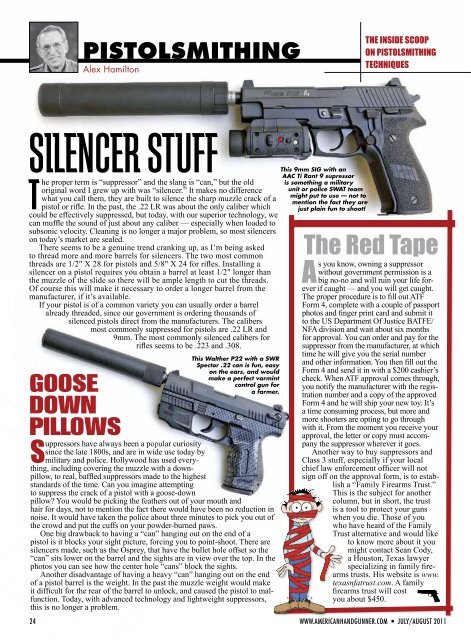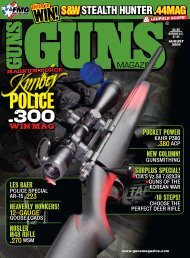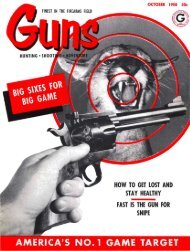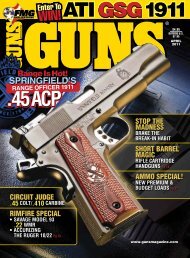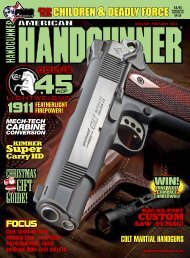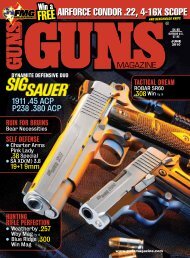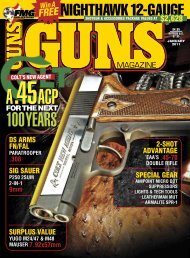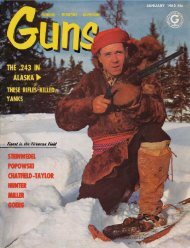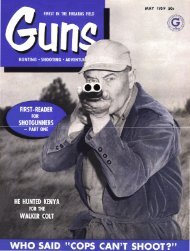American Handgunner Jul/Aug 2011 - Jeffersonian
American Handgunner Jul/Aug 2011 - Jeffersonian
American Handgunner Jul/Aug 2011 - Jeffersonian
Create successful ePaper yourself
Turn your PDF publications into a flip-book with our unique Google optimized e-Paper software.
PISTOLSMITHING<br />
Alex Hamilton<br />
THE INSIDE SCOOP<br />
ON PISTOLSMITHING<br />
TECHNIQUES<br />
Silencer Stuff<br />
The proper term is “suppressor” and the slang is “can,” but the old<br />
original word I grew up with was “silencer.” It makes no difference<br />
what you call them, they are built to silence the sharp muzzle crack of a<br />
pistol or rifle. In the past, the .22 LR was about the only caliber which<br />
could be effectively suppressed, but today, with our superior technology, we<br />
can muffle the sound of just about any caliber — especially when loaded to<br />
subsonic velocity. Cleaning is no longer a major problem, so most silencers<br />
on today’s market are sealed.<br />
There seems to be a genuine trend cranking up, as I’m being asked<br />
to thread more and more barrels for silencers. The two most common<br />
threads are 1/2" X 28 for pistols and 5/8" X 24 for rifles. Installing a<br />
silencer on a pistol requires you obtain a barrel at least 1/2" longer than<br />
the muzzle of the slide so there will be ample length to cut the threads.<br />
Of course this will make it necessary to order a longer barrel from the<br />
manufacturer, if it’s available.<br />
If your pistol is of a common variety you can usually order a barrel<br />
already threaded, since our government is ordering thousands of<br />
silenced pistols direct from the manufacturers. The calibers<br />
most commonly suppressed for pistols are .22 LR and<br />
9mm. The most commonly silenced calibers for<br />
rifles seems to be .223 and .308.<br />
Goose<br />
Down<br />
Pillows<br />
S<br />
uppressors<br />
This Walther P22 with a SWR<br />
Spector .22 can is fun, easy<br />
on the ears, and would<br />
make a perfect varmint<br />
control gun for<br />
a farmer.<br />
have always been a popular curiosity<br />
since the late 1800s, and are in wide use today by<br />
military and police. Hollywood has used everything,<br />
including covering the muzzle with a downpillow,<br />
to real, baffled suppressors made to the highest<br />
standards of the time. Can you imagine attempting<br />
to suppress the crack of a pistol with a goose-down<br />
pillow? You would be picking the feathers out of your mouth and<br />
hair for days, not to mention the fact there would have been no reduction in<br />
noise. It would have taken the police about three minutes to pick you out of<br />
the crowd and put the cuffs on your powder-burned paws.<br />
One big drawback to having a “can” hanging out on the end of a<br />
pistol is it blocks your sight picture, forcing you to point-shoot. There are<br />
silencers made, such as the Osprey, that have the bullet hole offset so the<br />
“can” sits lower on the barrel and the sights are in view over the top. In the<br />
photos you can see how the center hole “cans” block the sights.<br />
Another disadvantage of having a heavy “can” hanging out on the end<br />
of a pistol barrel is the weight. In the past the muzzle weight would make<br />
it difficult for the rear of the barrel to unlock, and caused the pistol to malfunction.<br />
Today, with advanced technology and lightweight suppressors,<br />
this is no longer a problem.<br />
This 9mm SIG with an<br />
AAC Ti Rant 9 supressor<br />
is something a military<br />
unit or police SWAT team<br />
might put to use — not to<br />
mention the fact they are<br />
just plain fun to shoot!<br />
The Red Tape<br />
As you know, owning a suppressor<br />
without government permission is a<br />
big no-no and will ruin your life forever<br />
if caught — and you will get caught.<br />
The proper procedure is to fill out ATF<br />
Form 4, complete with a couple of passport<br />
photos and finger print card and submit it<br />
to the US Department Of Justice BATFE/<br />
NFA division and wait about six months<br />
for approval. You can order and pay for the<br />
suppressor from the manufacturer, at which<br />
time he will give you the serial number<br />
and other information. You then fill out the<br />
Form 4 and send it in with a $200 cashier’s<br />
check. When ATF approval comes through,<br />
you notify the manufacturer with the registration<br />
number and a copy of the approved<br />
Form 4 and he will ship your new toy. It’s<br />
a time consuming process, but more and<br />
more shooters are opting to go through<br />
with it. From the moment you receive your<br />
approval, the letter or copy must accompany<br />
the suppressor wherever it goes.<br />
Another way to buy suppressors and<br />
Class 3 stuff, especially if your local<br />
chief law enforcement officer will not<br />
sign off on the approval form, is to establish<br />
a “Family Firearms Trust.”<br />
This is the subject for another<br />
column, but in short, the trust<br />
is a tool to protect your guns<br />
when you die. Those of you<br />
who have heard of the Family<br />
Trust alternative and would like<br />
to know more about it you<br />
might contact Sean Cody,<br />
a Houston, Texas lawyer<br />
specializing in family firearms<br />
trusts. His website is www.<br />
texasnfatrust.com. A family<br />
firearms trust will cost<br />
you about $450.<br />
*<br />
24 WWW.AMERICANHANDGUNNER.COM • JULY/AUGUST <strong>2011</strong>


